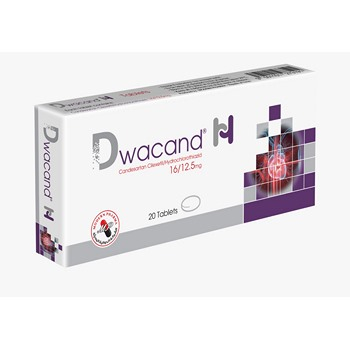Dwacand H16/12.5
- Candesartan cilexetil: is a prodrug, which is rapidly converted to the active drug, candesartan, by
ester hydrolysis during absorption from the gastrointestinal tract. Candesartan is an angiotensin II
receptor antagonist, selective for AT1 receptors, with tight binding to and slow dissociation from the
receptor. It has no agonist activity. Candesartan does not influence ACE or other enzyme systems
usually associated with the use of ACE inhibitors. Since there is no effect on the degradation of
kinins, or on the metabolism of other substances, such as substance P, angiotensin II receptor
antagonists are unlikely to be associated with cough. Candesartan does not bind to or block other
hormone receptors or ion channels known to be important in cardiovascular regulation.
The antagonism of the AT1 receptors results in dose related increases in plasma renin levels,
angiotensin I and angiotensin II levels, and a decrease in plasma aldosterone concentration.
- Hydrochlorothiazide: inhibits the active reabsorption of sodium, mainly in the distal kidney
tubules, and promotes the excretion of sodium, chloride and water. The renal excretion of potassium
and magnesium increases dose-dependently, while calcium is reabsorbed to a greater extent.
Hydrochlorothiazide decreases plasma volume and extracellular fluid and reduces cardiac output and
blood pressure. During long-term therapy, reduced peripheral resistance contributes to the blood
pressure reduction.
- Candesartan and hydrochlorothiazide: have additive antihypertensive effects. In hypertensive
patients, Dwacand®-H causes an effective and long-lasting reduction in arterial blood pressure
without reflex increase in heart rate.
- Absorption And Distribution: Candesartan cilexetil is rapidly and completely bioactivated by ester
hydrolysis from the gastrointestinal tract to candesartan. The average absolute bioavailability of
candesartan is approximately 40%. The mean peak serum concentration (Cmax) is reached in 3 - 4
hours after oral dministration. Candesartan is highly bound to plasma proteins (more than 99%).
The evident volume of distribution of candesartan is 0.1 L/kg. The pharmacokinetics of
candesartan is not gender related. The area under the serum concentration versus time curve
(AUC) of candesartan is not significantly affected by food. Hydrochlorothiazide: is rapidly
absorbed from the gastrointestinal tract with an absolute bioavailability of approximately 70%.
Concomitant intake of food increases the absorption by approximately 15%. The bioavailability
may decrease in patients with cardiac failure and pronounced oedema. The plasma protein binding
of hydrochlorothiazide is approximately 60%. The apparent volume of distribution is
approximately 0.8 L/kg.
- Metabolism and Elimination: Candesartan is mainly excreted unchanged in urine and bile.
It undergoes minor hepatic metabolism to an inactive metabolite.The terminal half-life of
candesartan is approximately 9 hours.Total plasma clearance of candesartan is about 0.37ml/
min/kg, with a renal clearance of about 0.19 ml/min/kg. Following an oral dose of 14 C-labelled
candesartan cilexetil, approximately 26% of the dose is excreted in the urine as candesartan and
7% as an inactive metabolite while approximately 56% of the dose is recovered in the faeces as
candesartan and 10% as the inactive metabolite.
- Hydrochlorothiazide is not metabolized and is excreted almost entirely as unchanged drug by
glomerular filtration and active tubular secretion.The terminal t1/ 2 of hydrochlorothiazide is
approximately 8 hours. Approximately 70% of an oral dose is eliminated in the urine within 48
hours.The half-life of ydrochlorothiazide remains unchanged (approximately 8 h) after
administration of hydrochlorothiazide in combination with candesartan cilexetil. No additional
accumulation of hydrochlorothiazide occurs after repeated doses of the combination compared to
monotherapy. The terminal t1/ 2 of hydrochlorothiazide is prolonged in patients with renal
impairment.


